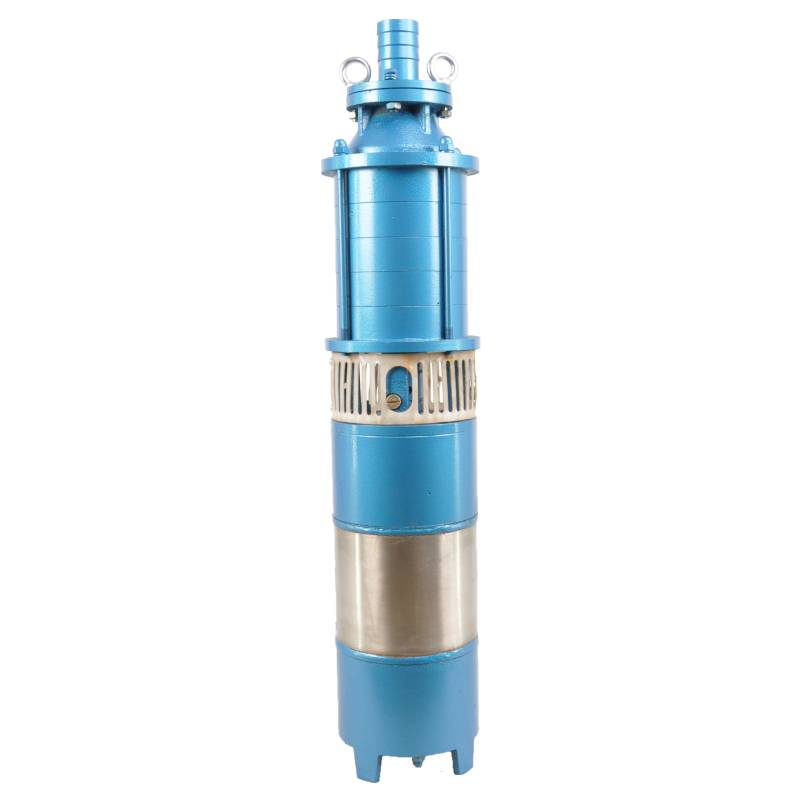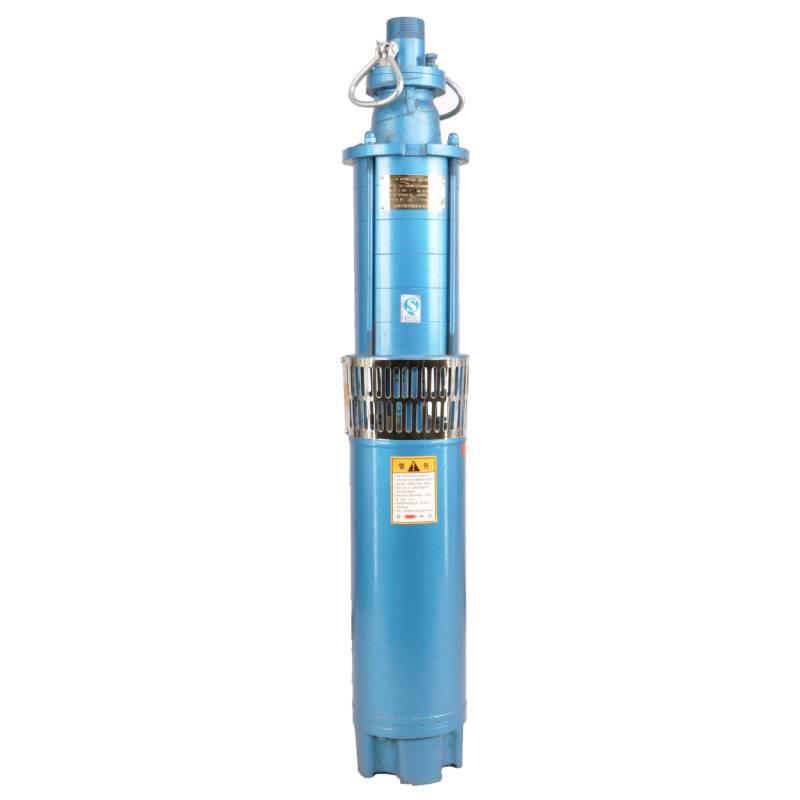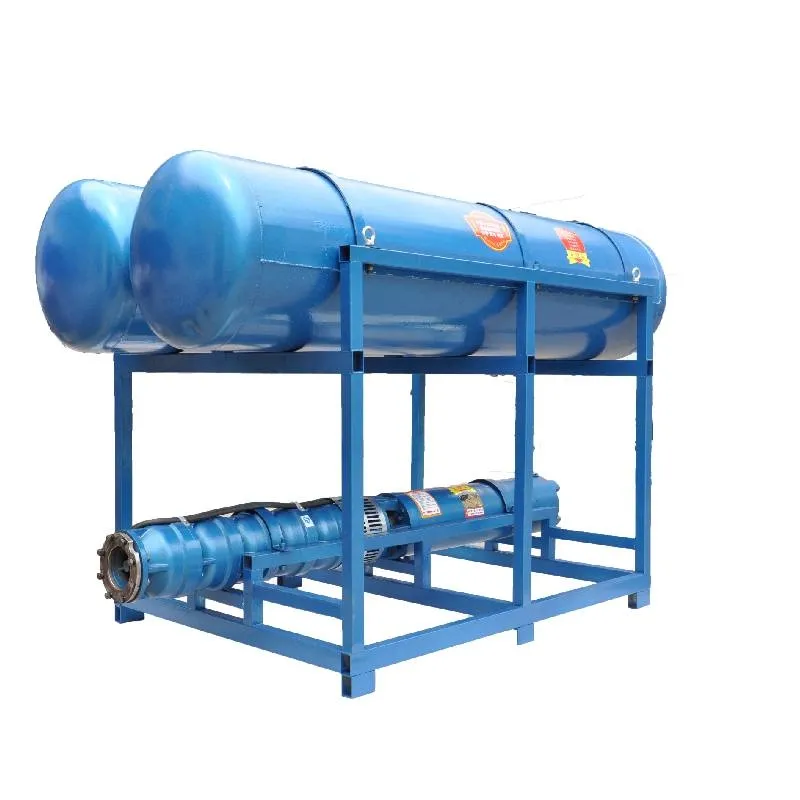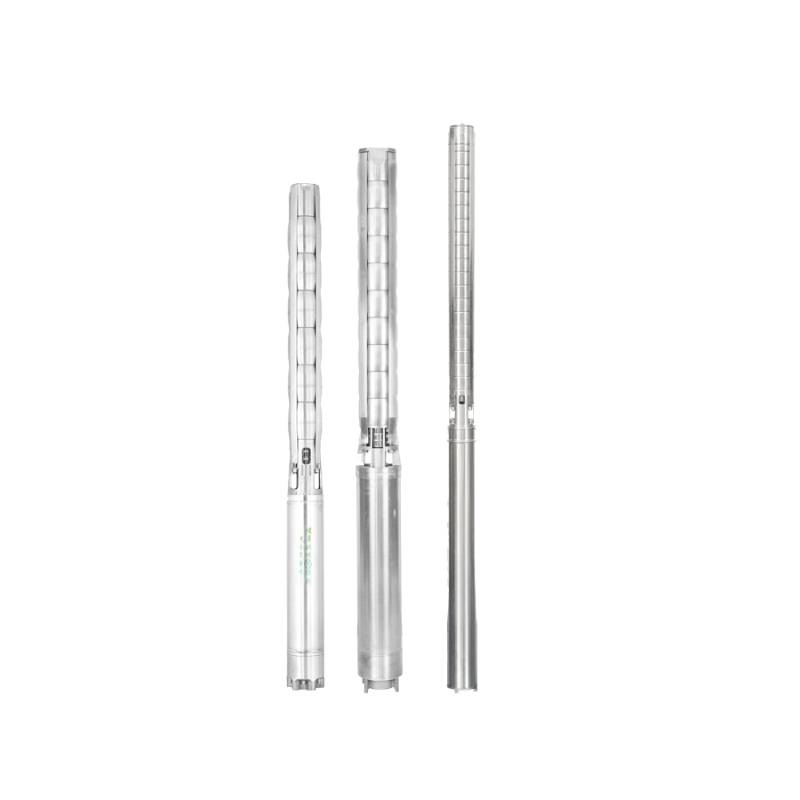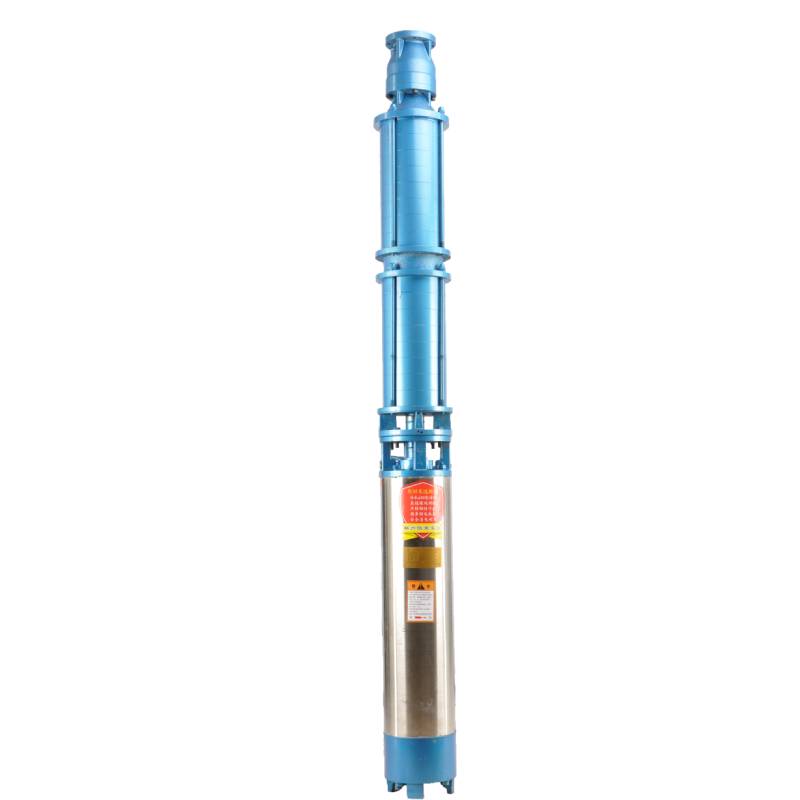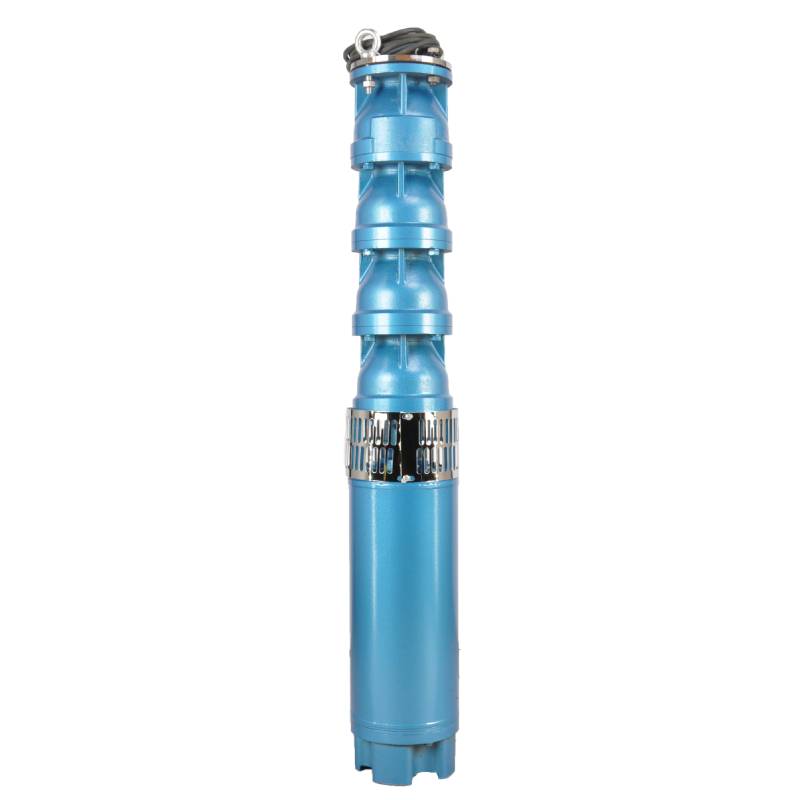ระบบไฟฟ้าใต้น้ำซีรีส์ QS เป็นเครื่องจักรชลประทานและการระบายน้ำรูปแบบใหม่ ปั๊มซีรีส์นี้เป็นแนวตั้ง โดยใช้การออกแบบใบพัดนำเชิงบวกและเชิงลบในแนวรัศมี ปริมาตรน้อย น้ำหนักเบา ยกสูง ติดตั้งและเคลื่อนย้ายง่าย บำรุงรักษาและใช้งานง่าย
ช่วงการไหล 5-50 ลบ.ม./ชม. ยกได้ 5-800 ม.
The product is equipped with three-phase AC 380V (tolerance is ± 5%), 50 Hz (tolerance is ± 1%) power supply. Water quality requirements are:
(1) water temperature shall not be higher than 20 °C;
(2) ปริมาณสิ่งสกปรกที่เป็นของแข็ง (อัตราส่วนมวล) จะต้องไม่เกิน 0.01%
(3) ค่าพีเอช (pH) คือ 6.5-8.5;
(4) ปริมาณไฮโดรเจนซัลไฟด์ต้องไม่เกิน 1.5 มก./ลิตร
(5) ปริมาณไอออนคลอไรด์ต้องไม่เกิน 400 มก. / ล. มอเตอร์เป็นโครงสร้างเปียกแบบปิดหรือเติมน้ำ
ก่อนการใช้งาน ช่องด้านในของมอเตอร์จุ่มจะต้องเต็มไปด้วยน้ำสะอาด และต้องขันน็อตฉีดน้ำและระบายอากาศให้แน่น มิฉะนั้น จะไม่ถูกใช้ ปั๊มจุ่มจะต้องจุ่มลงในน้ำอย่างสมบูรณ์จึงจะสามารถทำงานได้ ความลึกในการแทรกจะต้องไม่เกิน 70 เมตร และระยะห่างระหว่างด้านล่างของปั๊มจุ่มและก้นบ่อจะต้องไม่น้อยกว่า 3 เมตร การไหลของน้ำจากบ่อจะต้องเป็นไปตามข้อกำหนดปริมาณน้ำและการทำงานต่อเนื่องของปั๊มจุ่ม และปริมาณน้ำที่ส่งออกของปั๊มจุ่มจะต้องควบคุมที่ 0.7-1.2 เท่าของอัตราการไหลที่กำหนด บ่อน้ำจะต้องเป็นแนวตั้งและปั๊มจุ่มไม่สามารถใช้ในแนวนอนหรือแนวเอียงได้ แต่จะใช้ในแนวตั้งเท่านั้น ปั๊มจุ่มต้องจับคู่กับสายเคเบิลและติดตั้งอุปกรณ์ป้องกันโอเวอร์โหลดภายนอกตามที่ต้องการ ห้ามมิให้ทดสอบปั๊มจุ่มโดยเด็ดขาดโดยไม่มีปริมาณน้ำ
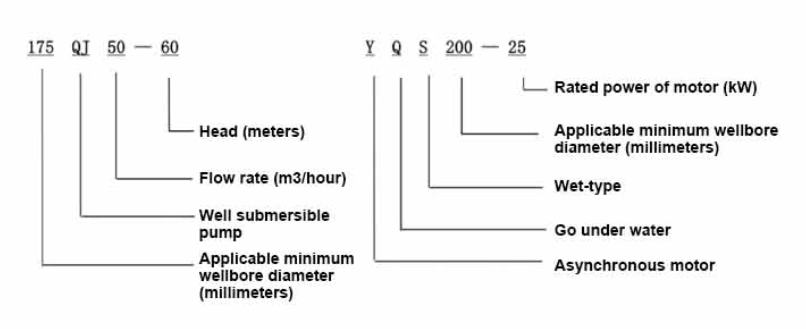
| ตารางแสดงประสิทธิภาพของปั๊มจุ่ม 200 QS ซีรี่ส์ที่กำหนดเองที่ไม่ได้มาตรฐาน |
||||||||
| แบบอย่าง | แบบอย่าง | |||||||
| คิวเอส5-70-2.2KW | คิวเอส10-52-4KW | |||||||
| QS5-90-3KW | คิวเอส10-70-5.5KW | |||||||
| คิวเอส5-108-4KW | คิวเอส10-90-7.5KW | |||||||
| คิวเอส5-126-5.5KW | คิวเอส10-108-7.5KW | |||||||
| คิวเอส5-144-5.5KW | คิวเอส20-40-4KW | |||||||
| QS5-160-7.5KW | คิวเอส20-54-5.5KW | |||||||
| คิวเอส5-180-7.5KW | คิวเอส20-65-7.5KW | |||||||
| คิวเอส10-36-2.2KW | คิวเอส20-81-7.5KW | |||||||
| คิวเอส10-54-3KW | คิวเอส32-13-2.2KW | |||||||
| คิวเอส10-70-4KW | คิวเอส32-26-4KW | |||||||
| คิวเอส10-90-5.5KW | คิวเอส32-52-7.5KW | |||||||
| คิวเอส10-108-5.5KW | คิวเอส40-39-7.5KW | |||||||
| คิวเอส10-126-7.5KW | คิวเอส40-13-4KW | |||||||
| คิวเอส10-140-7.5KW | คิวเอส40-26-5.5KW | |||||||
| คิวเอส15-38-3KW | คิวเอส50-13-4KW | |||||||
| คิวเอส15-54-4KW | คิวเอส50-26-5.5KW | |||||||
| คิวเอส15-65-5.5KW | คิวเอส50-39-7.5KW | |||||||
| คิวเอส15-81-5.5KW | คิวเอส63-12-4KW | |||||||
| คิวเอส15-100-7.5KW | คิวเอส63-24-7.5KW | |||||||
| คิวเอส20-30-3KW | คิวเอส80-11-4KW | |||||||
| คิวเอส20-45-4KW | คิวเอส80-22-7.5KW | |||||||
| คิวเอส20-60-5.5KW | คิวเอส10-88-7.5KW | |||||||
| คิวเอส20-75-7.5KW | คิวเอส10-105-7.5KW | |||||||
| คิวเอส20-81-7.5KW | คิวเอส40-52-11KW | |||||||
| คิวเอส10-198-15KW | คิวเอส50-60-11KW | |||||||
| คิวเอส10-160-9.2KW | คิวเอส65-30-9.2KW | |||||||
| คิวเอส15-180-15KW | คิวเอส80-28-9.2KW | |||||||
| คิวเอส10-180-11KW | คิวเอส125-15-7.5KW | |||||||
1, ปั๊มจุ่มดีสำหรับปั๊มน้ำสะอาด, ห้ามล้างบ่อใหม่, สูบตะกอนและน้ำโคลน,
2, ปั๊มน้ำแรงดันเกรด 380 / 50HZ, การใช้มอเตอร์จุ่มเกรดแรงดันไฟฟ้าอื่น ๆ จำเป็นต้องปรับแต่ง สาย Downhole ต้องใช้สายกันน้ำ จะต้องติดตั้งอุปกรณ์สตาร์ท เช่น กล่องจ่ายไฟสตาร์ทไม่พร้อม ควรมีฟังก์ชันการป้องกันมอเตอร์ทั่วไป เช่น การป้องกันการลัดวงจรไฟฟ้าเกิน การป้องกันเฟส การป้องกันแรงดันไฟฟ้าตก การป้องกันสายดิน การป้องกันรอบเดินเบา ในกรณีที่มีสภาวะผิดปกติ อุปกรณ์ป้องกันควรจะเดินทางได้ทันเวลา
3 ปั๊มจะต้องต่อสายดินที่เชื่อถือได้ในกระบวนการติดตั้งและใช้งาน ห้ามมิให้สวิตช์กดดึงเปียกมือและเท้า ก่อนติดตั้งและบำรุงรักษาปั๊มจะต้องตัดไฟก่อน ติดตั้งในตำแหน่งที่ใช้ปั๊มจะต้องมีเครื่องหมายกำกับไว้ชัดเจนว่า "ป้องกันไฟฟ้าช็อต" ก่อนลงบ่อหรือการติดตั้ง ต้องเติมน้ำกลั่นหรือน้ำเย็นสะอาดที่ไม่กัดกร่อนในช่องมอเตอร์ และขันน็อตน้ำ/ท่อระบายน้ำให้แน่น
4 เมื่อดำเนินการสัมภาษณ์ท้องถิ่นของปั๊ม น้ำจะต้องเทลงในห้องปั๊มเพื่อหล่อลื่นแบริ่งยาง เวลาเริ่มต้นทันทีจะต้องไม่เกินหนึ่งวินาที ตรวจสอบว่าทิศทางเหมือนกับคำสั่งบังคับเลี้ยวหรือไม่ เมื่อปั๊มตั้งตรง ควรคำนึงถึงความปลอดภัย ป้องกันการพลิกคว่ำและการบาดเจ็บ
5 อย่างเคร่งครัดตามบทบัญญัติของลิฟท์ปั๊ม ช่วงการไหลของการใช้งาน เพื่อป้องกันการไหลต่ำหรือแรงสูบน้ำยกสูง แบริ่งแรงขับและส่วนอื่น ๆ ของการสึกหรอ มอเตอร์โอเวอร์โหลดถูกเผา 6 หลังจากที่ปั๊มลงบ่อ การวัดความต้านทานของมอเตอร์กับฉนวนกราวด์ไม่ควรน้อยกว่า 100M หลังจากเริ่มสังเกตแรงดันและกระแส ให้ตรวจสอบฉนวนของขดลวดมอเตอร์ว่าเป็นไปตามข้อกำหนดหรือไม่ อุณหภูมิตำแหน่งเก็บปั๊มถ้าน้อยกว่าจุดเยือกแข็ง ควรทำให้น้ำในโพรงมอเตอร์แห้ง ป้องกันความเสียหายของน้ำแข็งในโพรงมอเตอร์ที่เกิดจากอุณหภูมิต่ำ
The pump part is mainly composed of pump shaft, impeller, guide housing, rubber bearing, check valve body (optional) and other components. The motor part mainly includes base, pressure regulating diaphragm, thrust bearing, thrust plate, lower guide bearing seat, stator, rotor, upper guide bearing seat, sand discharging ring, water inlet section, lead cable and other components. The main characteristics of this product are that the motor is a water-immersed three-phase asynchronous motor, and the motor cavity is filled with water to cool the motor and lubricate the bearing. The pressure regulating film at the bottom is used to adjust the pressure difference of the water body in the cavity caused by the temperature rise of the motor. In order to prevent the sand from entering the motor, the upper end of the motor shaft extension is equipped with two oil seals and installed a sand discharging ring, forming a sand prevention structure. At the same time, in order to prevent the pump shaft from jumping when starting, the pump shaft is connected with the motor shaft by a coupling, and the thrust bearing is installed under the motor. The lubrication of the whole product is water lubrication, and the motor stator winding is made of high quality submersible motor winding wire with high insulation performance. In addition, the pump is designed by computer CAD, with simple structure and excellent technical performance.

(1)การเตรียมการก่อนการติดตั้ง:
1. ตรวจสอบว่าปั๊มจุ่มตรงตามเงื่อนไขการใช้งานและขอบเขตที่ระบุในคู่มือหรือไม่
2. การใช้โอบีหนักๆ ที่มีเส้นผ่านศูนย์กลางเท่ากับเส้นผ่านศูนย์กลางภายนอกสูงสุดของปั๊มจุ่ม วัดว่าเส้นผ่านศูนย์กลางภายในของหลุมเจาะสามารถใส่ปั๊มจุ่มได้หรือไม่ และวัดว่าความลึกของหลุมตรงตามข้อกำหนดในการติดตั้งหรือไม่
3. ตรวจสอบว่าหลุมเจาะสะอาดหรือไม่ และน้ำในบ่อมีความขุ่นหรือไม่ ห้ามใช้ปั๊มไฟฟ้าแบบจุ่มเพื่อล้างโคลนปั๊ม Welor และน้ำทราย เพื่อหลีกเลี่ยงความเสียหายที่เกิดกับปั๊มไฟฟ้าแบบจุ่มก่อนวัยอันควร
4. ตรวจสอบว่าตำแหน่งของแคลมป์ติดตั้งหัวเชื่อมนั้นเหมาะสมหรือไม่และสามารถทนต่อคุณภาพของยูนิตทั้งหมดได้หรือไม่
5. ตรวจสอบว่าส่วนประกอบของปั๊มจุ่มเสร็จสมบูรณ์และติดตั้งอย่างถูกต้องตามแผนภาพการประกอบในคู่มือหรือไม่ ถอดตัวกรองออกและหมุนข้อต่อเพื่อดูว่าหมุนได้อย่างยืดหยุ่นหรือไม่
6. คลายเกลียวสกรูน้ำและเติมน้ำสะอาดที่ไม่กัดกร่อนลงในช่องมอเตอร์ (หมายเหตุ ต้องแน่ใจว่าได้เติมน้ำไว้) จากนั้นขันสกรูน้ำให้แน่น หลังจากฉีดน้ำเป็นเวลา 12 ชั่วโมง ความต้านทานของฉนวนของมอเตอร์ไม่ควรน้อยกว่า 150M Q เมื่อวัดด้วยโต๊ะเขย่า 500V
7. Cable joint, cut off a 120mm rubber sleeve from one end of the outgoing cable and the matching cable with an electrician's knifethen stagger the length of the three core wires in a stepped shape, peel off a 20mm copper core, scrape of the oxide layer on theoutside of the copper wire with a knife or sand cloth, and insert the two connected wire ends in palirs.After tying the layer tightly with fine copper wire, solder it thoroughly and firmly, and sand of any. burrs on the surface. Then, forthe three joints, use polyvester insulation tape to wrap them in a semi stacked manner for three lavers. Wrap the two ends of thewrapping layer tightywith nyion thread,and then use a semi stacked method to wrap the tape for three layers. Wrap the outellayer with high-pressure insulation tape for three layers. Finally, fold the threestrands together and repeatedly wrap them for fivelayers with high-pressure tape. Each layer must be tightly tied, and the interlayer joints must be tight and fimm to prevent water frompenetrating and damaging the insulation, After wrapping, soak in water at room temperature of 20 ’c for 12 hours, and measurethe insulation resistance with a shaking table, which should not be less than 100M Ω
แผนภาพกระบวนการเดินสายไฟที่แนบมามีดังนี้: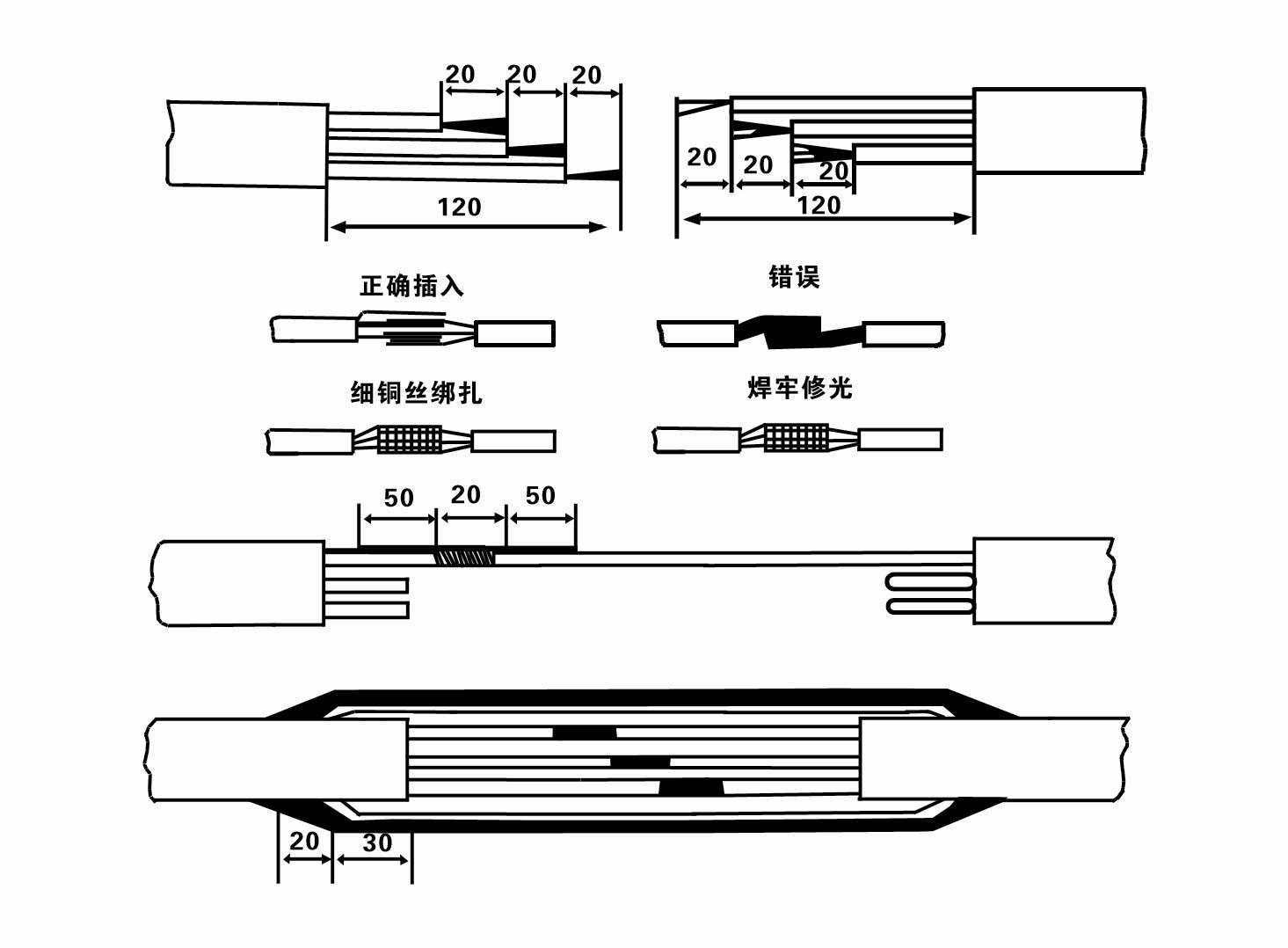
8. ใช้มัลติมิเตอร์เพื่อตรวจสอบว่าสายไฟสามเฟสเชื่อมต่ออยู่หรือไม่ และความต้านทานไฟฟ้ากระแสตรงมีความสมดุลโดยประมาณหรือไม่
9. ตรวจสอบว่าความจุของวงจรและหม้อแปลงไฟฟ้าโอเวอร์โหลดหรือไม่ จากนั้นเชื่อมต่อสวิตช์ป้องกันการโอเวอร์โหลดหรืออุปกรณ์สตาร์ท ดูตารางที่ 2 สำหรับรุ่นเฉพาะ จากนั้นเทถังน้ำลงในปั๊มน้ำจากทางออกของปั๊มน้ำเพื่อหล่อลื่นแบริ่งยางในปั๊ม จากนั้นวางปั๊มไฟฟ้าจุ่มตั้งตรงและมั่นคง เริ่มต้น (ไม่เกินหนึ่งวินาที) และตรวจสอบว่าทิศทางการบังคับเลี้ยวสอดคล้องกับป้ายบังคับเลี้ยวหรือไม่ ถ้าไม่เช่นนั้นให้สลับขั้วต่อของสายสามเฟสสองตัวใดก็ได้ จากนั้นติดตั้งตัวกรองและเตรียมลงบ่อ หากใช้ในโอกาสพิเศษ (เช่น คูน้ำ คูน้ำ แม่น้ำ สระน้ำ สระน้ำ ฯลฯ) ปั๊มไฟฟ้าจะต้องต่อสายดินอย่างเชื่อถือได้
(2) อุปกรณ์และเครื่องมือติดตั้ง:
1. โซ่ยกหนึ่งคู่รับน้ำหนักเกินสองตัน
2. ขาตั้งที่มีความสูงในแนวตั้งไม่น้อยกว่าสี่เมตร
3.เชือกแขวน 2 เส้น (ลวดสลิง) ที่รับน้ำหนักได้มากกว่า 1 ตัน (สามารถรับน้ำหนักปั๊มน้ำครบชุดได้)
4. ติดตั้งแคลมป์ (เฝือก) สองคู่
5. ประแจ ค้อน ไขควง เครื่องมือและเครื่องมือไฟฟ้า ฯลฯ
(3) การติดตั้งปั๊มไฟฟ้า:
1. แผนภาพการติดตั้งของปั๊มไฟฟ้าแบบจุ่มแสดงในรูปที่ 2 ขนาดการติดตั้งเฉพาะแสดงในตารางที่ 3 "รายการขนาดการติดตั้งของปั๊มไฟฟ้าแบบจุ่ม"
2. ปั๊มจุ่มไฟฟ้าที่มีส่วนหัวน้อยกว่า 30 เมตร สามารถยกเข้าบ่อได้โดยตรงโดยใช้ท่อและเชือกลวดหรือเชือกปออื่น ๆ ที่สามารถรับน้ำหนักเต็มเครื่องจักร ท่อน้ำ และน้ำในท่อได้
3. ปั๊มที่มีหัวมากกว่า 30 เมตร ใช้ท่อเหล็ก และมีลำดับการติดตั้งดังนี้
1.ใช้แคลมป์จับปลายด้านบนของส่วนปั๊มน้ำ (ขณะนี้มอเตอร์และปั๊มน้ำเชื่อมต่ออยู่) ยกด้วยโซ่แขวน แล้วค่อย ๆ มัดเข้ากับบ่อจนกระทั่งใส่แคลมป์บนหัวหลุมแล้วถอดออก โซ่แขวน
2) ใช้แคลมป์อีกคู่ในการยึดท่อ ยกด้วยโซ่แขวนให้ห่างจากหน้าแปลน 15 ซม. แล้วลดระดับลงอย่างช้าๆ ระหว่างหน้าแปลนท่อและหน้าแปลนปั๊มใส่แผ่นยางเข้าที่ และขันท่อให้แน่นและปั๊มให้เท่ากันด้วยสลักเกลียว น็อต และแหวนรองสปริง
3. ยกปั๊มจุ่มขึ้นเล็กน้อย ถอดแคลมป์ที่ปลายด้านบนของปั๊มน้ำออก มัดสายเคเบิลเข้ากับท่อน้ำให้แน่นด้วยเทปพลาสติก แล้วค่อยๆ มัดลงจนกระทั่งแคลมป์วางอยู่ที่หัวหลุมผลิต
④ใช้วิธีเดียวกันในการผูกท่อน้ำทั้งหมดเข้ากับบ่อ
⑤หลังจากเชื่อมต่อสายเคเบิลนำออกเข้ากับสวิตช์ควบคุมแล้ว จะเชื่อมต่อกับแหล่งจ่ายไฟสามเฟส
(4) สิ่งที่ควรทราบระหว่างการติดตั้ง:
1. หากพบปัญหาการติดขัดในระหว่างกระบวนการสูบน้ำ ให้หมุนหรือดึงท่อน้ำเพื่อผ่านจุดติดขัด หากมาตรการต่างๆ ยังไม่ได้ผล โปรดอย่าฝืนปั๊มลงเพื่อหลีกเลี่ยงความเสียหายต่อปั๊มไฟฟ้าใต้น้ำและบ่อน้ำ
2. ระหว่างการติดตั้งควรวางแผ่นยางไว้ที่หน้าแปลนของแต่ละท่อและขันให้แน่นเท่ากัน
3.เมื่อปั๊มน้ำลงบ่อควรวางตรงกลางท่อบ่อเพื่อป้องกันไม่ให้ปั๊มวิ่งชนผนังบ่อเป็นเวลานานทำให้ปั๊มสั่นสะเทือนและมอเตอร์กวาดและไหม้ .
4. กำหนดความลึกของปั๊มน้ำถึงก้นบ่อตามสภาพทรายและตะกอนของบ่อ อย่าฝังปั๊มไว้ในโคลน ระยะห่างจากปั้มน้ำถึงก้นบ่อโดยทั่วไปไม่น้อยกว่า 3 เมตร (ดูรูปที่ 2)
5. ความลึกในการป้อนน้ำของปั๊มน้ำควรอยู่ห่างจากระดับน้ำแบบไดนามิกถึงโหนดน้ำเข้าไม่ต่ำกว่า 1-1.5 เมตร (ดูรูปที่ 2) มิฉะนั้นลูกปืนปั๊มน้ำอาจเสียหายได้ง่าย
6. การยกปั๊มน้ำต้องไม่ต่ำเกินไป มิฉะนั้น จะต้องติดตั้งวาล์วประตูบนท่อส่งน้ำของหลุมผลิตเพื่อควบคุมการไหลของปั๊มที่จุดไหลที่กำหนด เพื่อป้องกันไม่ให้มอเตอร์ทำงานหนักเกินไปและไหม้เนื่องจากอัตราการไหลที่สูง
7. เมื่อปั๊มน้ำทำงาน น้ำที่ส่งออกควรต่อเนื่องและสม่ำเสมอ กระแสควรจะคงที่ (ภายใต้สภาวะการทำงานที่กำหนด โดยทั่วไปไม่เกิน 10% ของกระแสที่กำหนด) และไม่ควรมีการสั่นสะเทือนหรือเสียงรบกวน หากมีความผิดปกติควรหยุดเครื่องเพื่อหาสาเหตุและกำจัดทิ้ง
8. เมื่อติดตั้ง ให้ใส่ใจกับการตั้งค่าสายดินของมอเตอร์ (ดูรูปที่ 2) เมื่อท่อน้ำเป็นท่อเหล็กให้ดึงออกจากแคลมป์หลุมผลิต เมื่อท่อน้ำเป็นท่อพลาสติกให้เดินออกจากเครื่องหมายกราวด์ของปั๊มไฟฟ้า
The use of underwater pumps need to be carried out in strict accordance with the following steps: First of all, after the installation of the underwater pump, it is necessary to recheck the insulation resistance and the three-phase continuity of the switch, and check whether there are errors in the connection of the instrument and the start equipment. If there is no problem, you can start to test the machine. After the start, observe whether the indication readings of each instrument are correct. If the rated voltage and current specified on the nameplate are exceeded, please observe whether the pump has any noise or vibration. If everything is normal, it can be put into operation. The second step, after the pump runs for four hours for the first time, it should be closed and the thermal insulation resistance of the motor should be tested quickly. Its value should not be less than 0.5 megaohm. The third step, after the pump stops, it should be restarted after five minutes to prevent the water column in the pipeline from completely reversing, resulting in the motor burning due to excessive current. The fourth step, after the pump is put into normal operation, in order to prolong its service life, it is necessary to check the power supply voltage, operating current and insulation resistance regularly to see if they are normal. If the following conditions are found, the machine should be shut down immediately to troubleshoot:
1 the current exceeds 20% under the rated working conditions.
2 the dynamic water level drops to the inlet section, causing intermittent drainage.
3 the underwater pump vibrates violently or makes a lot of noise.
4 the supply voltage is lower than 340 volts.
5 a fuse burned. 6 water pipe damage.
7 the motor to the ground thermal insulation resistance is less than 0.5 megaohms.
The fifth step, the removal of the unit:
1 untie the cable tether, remove the pipe part, and remove the line protection plate.
2 screw down the water bolt and discharge all the water in the motor chamber.
3 remove the filter and loosen the fixing screw on the coupling fixed motor shaft.
4 screw down the bolt connecting the water inlet section and the motor, separate the pump and the motor (pay attention to make the unit level to prevent the bending of the pump shaft when separating)
5 the removal sequence of the pump is: (see Figure 1) water inlet section, impeller, shunt shell, impeller, check valve body. When removing the impeller, use special tools to loosen the cone sleeve fixed the impeller. In the process of removal, avoid bending the pump shaft and damage the various parts.
6 the removal process of the motor is: (see Figure 1) put the motor on the platform, and in order from the bottom of the motor bolt nuts, base, shaft head lock nut, thrust plate, key and lower guide bearing seat (iron rod bolt) on the connecting parts, and then take out the stator (careful not to damage the wire packet), and finally remove the connecting part and the upper guide bearing seat. Unit assembly: before assembly, rust and dirt on each component should be cleaned and sealant should be applied to each mating surface and fastener, and then the assembly should be carried out in reverse order of disassembly (the motor shaft moves about 1 mm after assembly), the coupling should be flexible after assembly, and then the filter should be put on for testing. Step six, after each use of the underwater electric pump operation for one year, or less than one year but immersed for two years, the disassembly and inspection should be carried out in accordance with the provisions of Article 5 to replace the worn parts.
1. ใส่น้ำในช่องมอเตอร์ออก (โดยเฉพาะในฤดูหนาวเพื่อป้องกันไม่ให้มอเตอร์เป็นน้ำแข็ง) และมัดสายเคเบิลให้ดี
2, store in an indoor room without corrosive substances and gases, with a temperature below 40 °C.
3 การใช้งานในระยะยาวควรคำนึงถึงการป้องกันสนิมของปั๊มจุ่ม
- ใบพัด
- ปลอกเพลา
- ยางหุ้มเพลา
-
แหวนซีล
01 ปริมาณน้ำจากบ่อลึก
02 การจ่ายน้ำในอาคารสูง
03 น้ำประปาภูเขา
04 หอคอยน้ำ
05 การชลประทานการเกษตร
06 การชลประทานในสวน
07 ปริมาณน้ำในแม่น้ำ
08 น้ำในประเทศ


